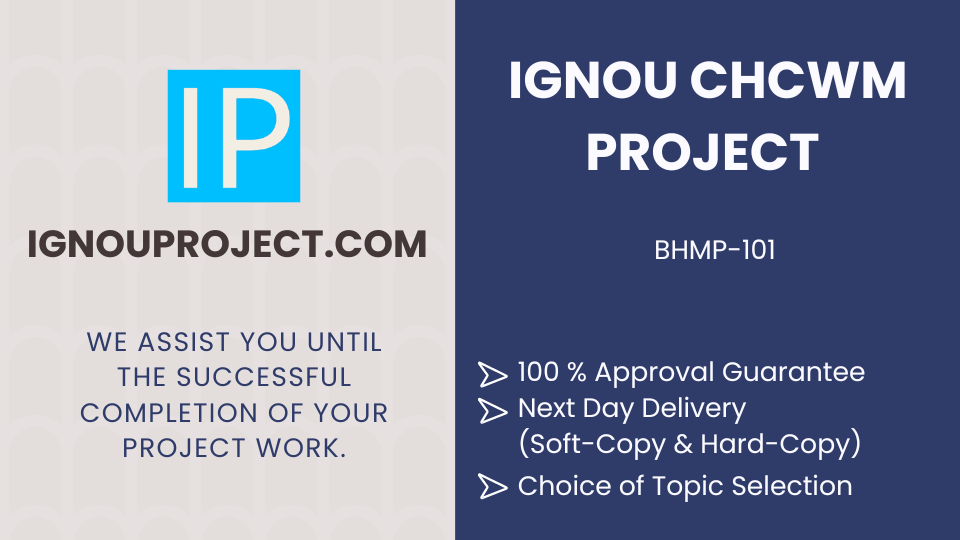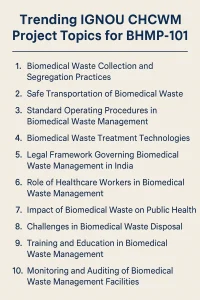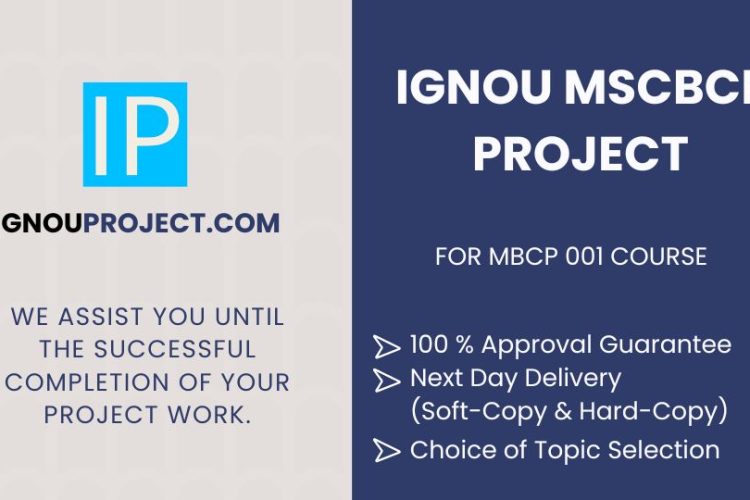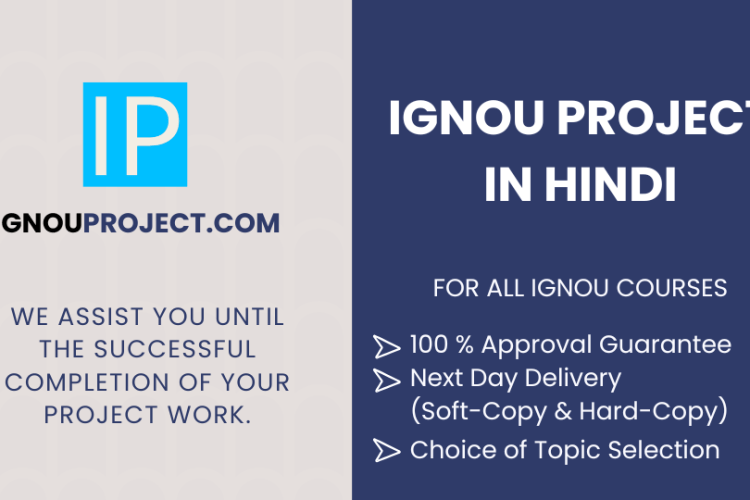
The Certificate in Health Care Waste Management (CHCWM) is designed to build practical skills in safe handling of biomedical waste, legal compliance, and workplace safety. Within this programme, the IGNOU CHCWM Project (BHMP-101) course focuses on real-world application of these ideas through a structured field-based study.
The CHCWM Project work concerns about biomedical waste management have been felt around the world because of the careless way that health care waste is thrown away and the rise in dangerous diseases like AIDS and Hepatitis-B. Because of this, it is very important to teach different health care workers how to handle health care waste. So that these health care workers can get what they need, the School of Health Sciences at IGNOU and WHO at SEARO have come up with an IGNOU CHCWM Project (BHMP-101) for countries in South-East Asia.
BHMP-101 allows learners to study actual health care waste practices in hospitals, clinics, laboratories, or other health facilities and then suggest realistic improvements. This project carries credit weight and plays a key role in successful completion of the CHCWM programme.
Overview of the IGNOU CHCWM Project (BHMP-101)
BHMP-101 is the project component of the CHCWM programme. It usually carries 2 credits and is completed after or along with the theory courses and workshop.
The project is meant to help learners:
- Apply rules and guidelines of health care waste management in real settings
- Study gaps in segregation, storage, transport and treatment of biomedical waste
- Understand worker and patient safety issues related to waste handling
- Develop practical, low-cost recommendations for improvement
The project must be original, ethical, and based on proper data collection from a real field site or a well-defined secondary data set.
Code Clarification and Place of BHMP-101 in CHCWM
The CHCWM programme is built around theory courses, optional units, a workshop and the project. BHMP-101 is the unique project code assigned to the compulsory project course.
In simple terms:
- Programme: CHCWM (Certificate in Health Care Waste Management)
- Project Course Code: BHMP-101
- Nature: Project work / field-based study
- Credits: Usually 2 credits
- Output: Approved synopsis + final project report
Completion of BHMP-101 is essential for fulfilment of the credit requirement and for getting the programme certificate.
IGNOU CHCWM Project Guidelines for BHMP-101
Although exact rules may change over time, the following general guidelines apply to most BHMP-101 projects:
- Work must be original and not copied from ready-made reports
- The project must relate directly to health care waste management
- Data should be collected ethically, with permission from authorities
- Confidential information of patients or staff must not be disclosed
- All tables, charts and figures must be clearly labelled
- Language should be clear, formal and free from spelling errors
Learners should always check the latest project guidelines and schedule from official programme documents before final submission.
Purpose of the BHMP-101 Project
The BHMP-101 project strengthens practical understanding of waste-handling systems in real health settings. It helps learners apply core concepts such as segregation, colour-coding, safe transport, interim storage, treatment options and worker safety measures. The CHCWM project also trains learners to identify gaps in compliance and propose feasible solutions that improve overall hygiene and reduce infection risks.
Importance of the BHMP-101 Project in the CHCWM Programme
This project is not only an academic requirement; it builds real-world competence in safe waste practices. Graduates gain stronger awareness of environmental health, infection prevention, and workplace safety principles. Completion of the project demonstrates the ability to apply theory to practice, which is particularly important for professionals working in hospitals, laboratories, clinics, and community health settings.
Improving CHCWM Project Quality Through Clear Objectives
Well-defined objectives guide the entire study. Effective objectives often revolve around:
- Measuring compliance with waste-segregation rules
- Identifying gaps in handling, storage or transport
- Assessing staff knowledge, behaviour and safety practices
- Examining the effectiveness of monitoring systems
- Suggesting low-cost improvements in waste-management processes
Clear objectives ensure that data collection remains structured and the final analysis stays focused.
IGNOU CHCWM Project Topic Selection for BHMP-101
Choosing the right topic is the most important early decision. A good topic should be focused, feasible with limited time, and directly related to health care waste management.
Steps for Selecting a BHMP-101 Project Topic
- Understand the major areas of health care waste: segregation, collection, transport, treatment, disposal, and safety
- List personal interests, such as infection control, worker safety, or technology
- Identify a nearby hospital, clinic, lab, or nursing home where data collection is possible
- Discuss feasibility with the guide or supervisor
- Finalise a topic that can be completed within the course duration
Sample IGNOU CHCWM Project Topic Ideas
Learners may consider topics such as:
- Compliance with colour-coded waste segregation in a multi-specialty hospital
- Management of sharps waste in a primary health centre
- Assessment of training needs of waste handlers in a district hospital
- Comparison of biomedical waste practices between a public and a private hospital
- Evaluation of use of personal protective equipment among waste handlers
- Study of storage and transport of health care waste in a laboratory network
- Audit of documentation and record keeping for biomedical waste in a clinic
Top Trending CHCWM Project Topics List
- Study of colour-coded waste segregation compliance in a tertiary care hospital
- Assessment of biomedical waste handling practices in a primary health centre
- Evaluation of personal protective equipment (PPE) use among waste handlers
- Audit of sharps disposal and injury prevention strategies in a clinical setting
- Analysis of biomedical waste storage and transport at a diagnostic laboratory
- Review of waste documentation and record-keeping in an outpatient department
- Comparison of waste management practices between public and private facilities
- Survey of staff training effectiveness in health care waste protocols
- Assessment of environmental safety and waste-treatment methods at a healthcare facility
- Mapping waste flow and risk points in a district hospital

Image: Trending IGNOU CHCWM Project Topics for BHMP-101
These are only examples. Each learner should tailor the topic to local needs and actual access to data.
Synopsis Requirements (BHMP-101)
The synopsis is a brief plan of the study and must be approved before CHCWM project work begins. A strong synopsis includes:
- Title Page: Project title, learner details, programme name, project code, study centre.
- Introduction: Short background on health care waste and the context of the selected facility.
- Problem Statement: Clear gap or issue to be examined.
- Objectives: Three to five measurable aims.
- Scope & Limitations: Location, boundaries and constraints.
- Methodology: Study design, sample, tools (checklists, questionnaires), and analysis methods.
- Proposed Chapter Plan: Outline of expected report structure.
- Time Schedule: Steps from data collection to report submission.
The synopsis must be typed, concise and signed by the learner and guide.
IGNOU CHCWM Project Report Format
After synopsis approval and fieldwork, the report is prepared in a structured format:
- Title Page
- Certificate & Acknowledgement
- Abstract
- Chapter 1: Introduction – background, profile of facility, problem statement, objectives.
- Chapter 2: Review of Related Studies – brief reference to existing practices.
- Chapter 3: Methodology – design, sample, tools, data collection and analysis.
- Chapter 4: Data Analysis & Findings – tables, charts and key observations.
- Chapter 5: Discussion – interpretation of results.
- Chapter 6: Conclusion & Recommendations – concise takeaways and practical suggestions.
- Bibliography & Annexures
The report should be precise, well-organised and focused on waste management practices.
Structuring Data Collection in CHCWM Project
A CHCWM project uses simple tools for field data collection. Common tools include:
- Observation checklists
- Staff interview schedules
- Waste-flow mapping charts
- Daily waste-recording sheets
- Photographs (if permitted) for documentation
Data should be collected at different times of the day to capture actual practices, not only ideal behaviour.
IGNOU CHCWM Project Guide / Supervisor Eligibility
A guide must be qualified and experienced in health, environment or waste-management roles. Suitable guides include:
- Medical officers
- Senior nurses
- Hospital administrators
- Waste-management officers
- Public or environmental health faculty
The guide helps refine the topic, approves the synopsis, reviews drafts and certifies originality.
Submission Process in IGNOU CHCWM Project
- Submit synopsis for approval with the guide’s signature.
- Conduct the study as per the approved plan.
- Prepare the report, incorporate guide feedback and finalise formatting.
- Submit the bound report with the guide’s certificate to the designated centre before the deadline.
Learners should always confirm the current schedule for project submission.
FAQs on IGNOU CHCWM Project for BHMP-101
What is BHMP-101 in the CHCWM programme?
BHMP-101 is the project course in the CHCWM programme. It carries credit weight and requires a field-based or facility-based health care waste management study.
What is the usual length of the BHMP-101 project report?
Most reports range between 8,000 and 12,000 words, depending on topic and data. The focus should be on clear analysis rather than size alone.
Are group projects allowed for BHMP-101?
Rules vary, but the project is usually treated as individual work. Even if data is collected jointly, each learner must submit an independent report.
Is it safe to buy and submit a ready-made CHCWM project?
This practice is risky. Repeated or copied projects may be rejected, and academic integrity is at stake. Unique, self-prepared work is always safer.
Is a hospital visit compulsory for BHMP-101?
Most topics require contact with a health facility. If access is limited, learners should select topics based on available settings or secondary data with guide approval.
Downloadable Resources
Final Words
The IGNOU CHCWM Project for BHMP-101 is more than a formal requirement. It is a chance to study real problems in health care waste management and to suggest practical steps that protect workers, patients and the environment.
Learners who feel uncertain about topic choice, synopsis writing or report structure can benefit from expert guidance and structured support. For help with project idea selection, synopsis drafting and report review for the IGNOU CHCWM Project (BHMP-101), learners may explore specialised project support services available at ignouproject.com or contact us.

